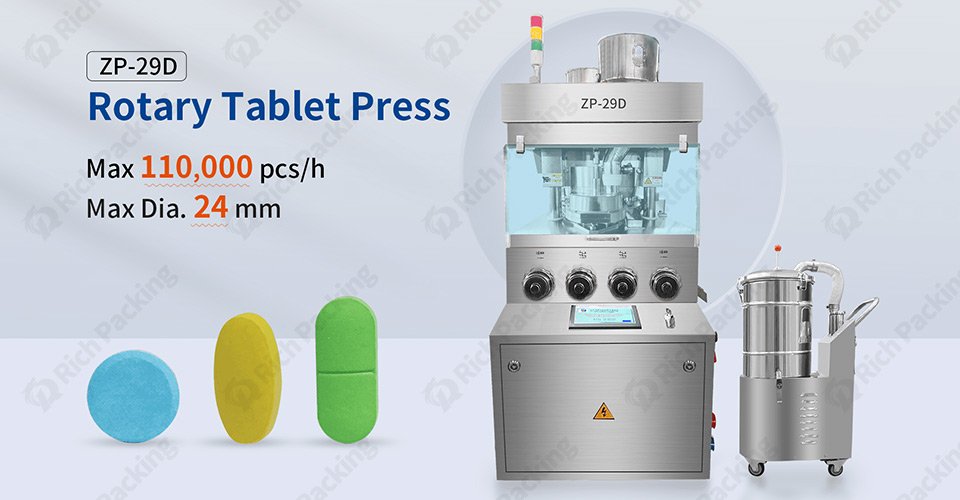Categories
New Blog
Tags
In the realm of pharmaceutical manufacturing, the rotary tablet pressing machine plays a pivotal role in converting raw materials into solid dosage forms. While TPMRs are designed for efficiency and reliability, they are not immune to operational challenges. Understanding these common issues and how to address them is vital for maintaining optimal production processes and ensuring the quality of the final product.
This comprehensive guide will delve into the most frequent challenges faced by operators of tablet pressing machines rotary (TPMRs). We'll explore each issue in depth, discuss the underlying causes, and provide practical solutions to help you keep your TPMR running smoothly and producing high-quality tablets consistently.

One of the most critical factors affecting the quality of tablets produced by a tablet pressing machine rotary is the compression force. Variations in compression force can lead to inconsistencies in tablet hardness, which can impact the dissolution rate and ultimately the efficacy of the medication.
Underlying Causes:
- Worn or Misaligned Dies: Dies that are worn out or not properly aligned can cause fluctuations in the amount of pressure applied during the compression cycle.
- Faulty Sensors: Sensors that monitor the compression force might malfunction, leading to inaccurate readings and inconsistent pressure application.
Solutions:
- Regular Maintenance and Calibration: Conduct routine inspections of the dies and sensors to ensure they are functioning correctly. Replace worn parts and recalibrate the sensors as needed.

The dies used in a tablet pressing machine rotary undergo significant stress during the tablet-making process. Over time, this wear and tear can lead to deformities in the die surfaces, resulting in poor tablet shape or surface defects.
Underlying Causes:
- High Production Rates: Running the machine at high speeds can accelerate the wear on the dies.
- Poor Lubrication: Inadequate lubrication can cause increased friction and wear on the dies.
Solutions:
- Preventive Maintenance Schedule: Implement a preventive maintenance schedule that includes regular inspection and replacement of worn dies. Consider using high-quality materials for your dies to increase their lifespan.
- Proper Lubrication: Ensure that the dies are properly lubricated before each production run to reduce friction and wear.
Sticking occurs when the tablet material adheres to the punch or die surfaces instead of being released. This can cause uneven tablet weights and affect the overall yield of the process.
Underlying Causes:
- Incorrect Formulation: A formulation with too much or too little binder can cause sticking issues.
- Insufficient Lubrication: Insufficient lubrication can also contribute to sticking problems.
Solutions:
- Adjust Binders and Lubricants: Adjust the binders and lubricants in your formulation to reduce sticking. Consult with a formulator to optimize the balance between binding and lubricating properties.
- Proper Lubrication: Ensure that all components of the tablet pressing machine rotary are properly lubricated. Regularly check and adjust the lubrication levels to maintain optimal conditions.
Tablets may split or crack along the score line or other areas if the pressure applied during the compression stage is too high or if the material is not cohesive enough.
Underlying Causes:
- Excessive Pressure: Applying too much pressure during the compression stage can cause splitting or cracking.

Solutions:
- Optimize Formulation and Compression Settings: Optimize the formulation and compression settings to ensure adequate cohesion without excessive pressure. Regularly inspect the tablets for signs of cracking and adjust the process accordingly.
- Use Appropriate Binders: Incorporate binders that enhance the cohesion of the tablet material without compromising the disintegration properties.
Lamination refers to the separation of layers within a tablet, while delamination is the separation between the tablet and its coating. These issues can compromise the integrity and stability of the final product.
Underlying Causes:
- Moisture Content: High moisture content in the granulation can cause lamination and delamination.
- Poor Mixing: Inconsistent mixing of the tablet ingredients can also contribute to these issues.
Solutions:
- Control Moisture Content: Monitor the moisture content of the granulation to prevent lamination and delamination. Use a moisture analyzer to ensure the granulation is within the acceptable range.
- Uniform Mixing: Implement a uniform mixing process to ensure consistent distribution of ingredients throughout the granulation.
Variation in tablet weight is a common issue that can arise due to irregular feeding or inconsistencies in the compression process.
Underlying Causes:
- Irregular Feeding: Fluctuations in the amount of material fed into the machine can cause variations in tablet weight.
- Inaccurate Scales: If the scales used to measure the weight of the tablets are not accurate, it can lead to weight variation.
Solutions:
- Implement Uniform Feeding Mechanism: Implement a uniform feeding mechanism and use high-precision scales to monitor the weight of each tablet. Adjust the feeding system as necessary to maintain consistent weight.
- Regular Calibration: Regularly calibrate the scales to ensure accurate measurements.
Picking occurs when small particles adhere to the surface of the tablet, while capping refers to the detachment of one or both ends of a tablet. Both issues can lead to uneven tablet appearance and reduced product quality.
Underlying Causes:
- Inadequate Compression Force: Insufficient compression force can cause picking and capping.
- Poor Granulation: Poorly formed granules can stick to the tablet surface, causing picking, and may also contribute to capping.
Solutions:
- Use High-Speed Camera: Use a high-speed camera to analyze the tablet ejection process and identify potential causes of picking and capping. Adjust the compression force and speed to minimize these effects.
- Granulation Optimization: Optimize the granulation process to ensure that the granules are well-formed and do not stick to the tablet surface.
Maintaining the optimal performance of your tablet pressing machine requires attention to detail and proactive problem-solving. By addressing these common issues, you can ensure that your TPMR continues to produce high-quality tablets efficiently and reliably. Regular maintenance, precise calibration, and continuous improvement of the manufacturing process are key to overcoming the challenges faced by TPMRs.